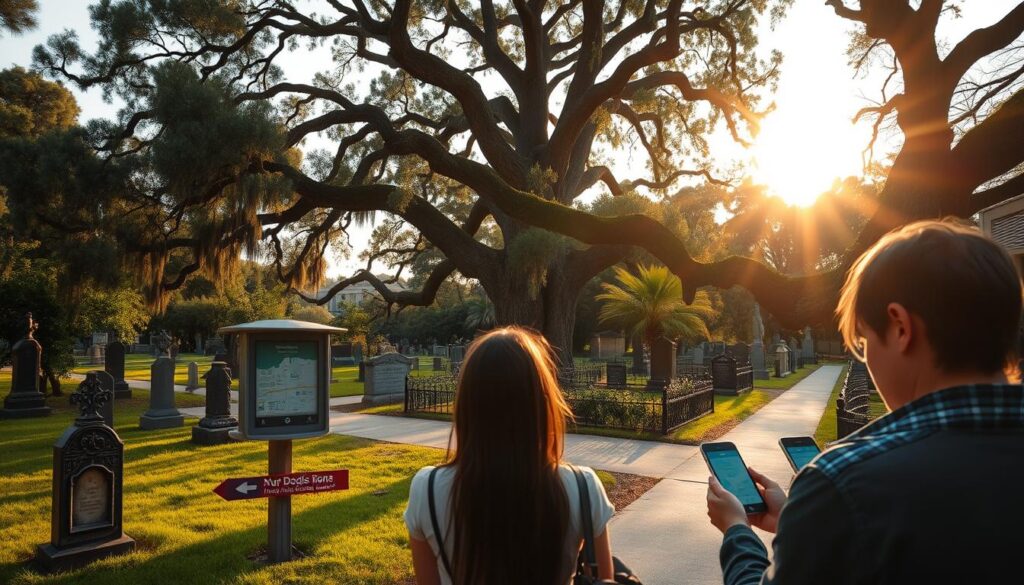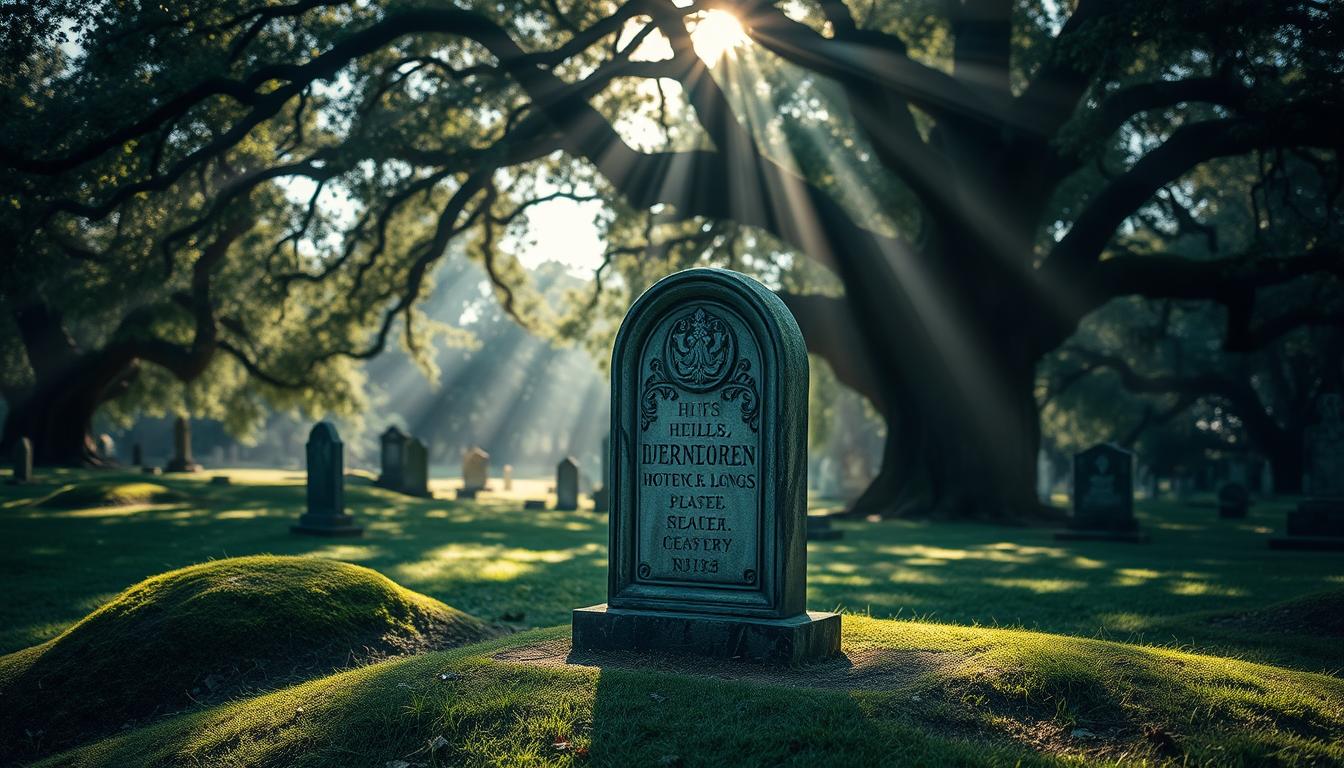How to Find a Gravesite in a Cemetery
Finding a gravesite can be a daunting task, especially when you’re unsure where to start. Whether you’re researching your family history or paying your respects to a deceased loved one, knowing how to navigate a cemetery is essential.
Many people face challenges when trying to find a grave, due to the vast number of graves in a typical cemetery. However, with the right guidance, you can efficiently locate the gravesite you’re looking for.
This article will guide you through the process, providing you with the necessary tools and information to successfully find a gravesite.
Key Takeaways
- Understand the importance of preparation before visiting a cemetery.
- Learn how to use cemetery maps and records to locate a gravesite.
- Discover the benefits of contacting cemetery administration or local genealogical societies.
- Explore online resources and databases for finding graves.
- Gain tips on what to do when you’re unable to find a gravesite.
Understanding Cemetery Organization
To find a gravesite by name, one must first comprehend how cemeteries are typically organized. Cemeteries, whether public, private, or religious, follow certain structures that aid in the location of specific gravesites.
Common Cemetery Layouts
Cemeteries are laid out in various ways, but most follow a grid or a sectional pattern. The grid pattern is often seen in modern cemeteries, where sections are divided into rows and plots. Older or historical cemeteries might have a more random or organic layout, reflecting the era and cultural practices of the time.
Section, Row, and Plot Numbering Systems
A key aspect of cemetery organization is the numbering system used to identify gravesites. Typically, cemeteries are divided into sections, with each section further divided into rows and plots. For example, a gravesite might be identified as “Section 12, Row 3, Plot 5.” Understanding this system is crucial for locating a specific grave.
Different Types of Cemeteries and Their Organization
The organization of a cemetery can also depend on its type. Public, private, and religious cemeteries each have their own organizational structures.
Public vs. Private Cemeteries
Public cemeteries are generally more structured, with clear signage and well-maintained records. Private cemeteries, on the other hand, might have more variability in their organization, as they are often managed by individuals or private companies.
Religious Cemetery Structures
Religious cemeteries, such as Catholic or Jewish cemeteries, may have specific rules and layouts that reflect their religious traditions. For instance, some religious cemeteries require graves to be oriented in a certain direction.
Gathering Information Before Your Visit
To successfully find a grave, you need to be well-prepared with the right information. Gathering relevant details about the deceased is a crucial step that can significantly simplify your search.
Essential Details to Collect About the Deceased
When searching for a gravesite, having the correct information is paramount. The most critical details include the full name of the deceased and their birth and death dates.
Full Name and Variations
It’s essential to know the full name of the deceased, including any variations or nicknames that might be used. Sometimes, records may contain misspellings or different versions of the name, so being aware of these variations can help you locate the correct grave.
Birth and Death Dates
Knowing the birth and death dates can help narrow down the search. These dates can be crucial in distinguishing between individuals with similar names.
Death Certificates and Obituaries as Resources
Death certificates and obituaries are valuable resources that can provide essential information. Death certificates typically contain the full name, birth and death dates, and burial location. Obituaries can offer additional details such as the names of family members and the cemetery where the person is buried.
Family Records and Their Importance
Family records, including genealogy documents and family trees, can be invaluable in your search. They can provide names, dates, and relationships that can help you locate the gravesite.
| Information Type | Importance | Example |
|---|---|---|
| Full Name | High | John Doe |
| Birth and Death Dates | High | January 1, 1900 – December 31, 1980 |
| Death Certificate | High | Official document with burial details |
| Obituary | Medium | Newspaper or online notice with burial info |
| Family Records | Medium | Genealogy documents and family trees |
Online Resources for Locating Gravesites
In today’s digital landscape, finding a gravesite is made easier with the plethora of online resources at your disposal. You can now access a vast array of information from the comfort of your home, significantly simplifying the process of locating a gravesite.
Find A Grave and BillionGraves Websites
Websites like Find A Grave and BillionGraves are invaluable resources for anyone searching for gravesites. These platforms aggregate cemetery records, making it easier to locate specific graves. You can search by name, location, or other relevant details.
Find A Grave, for instance, offers a comprehensive database that includes military records, allowing you to find gravesites of veterans and their families. BillionGraves, on the other hand, focuses on cemetery records and provides detailed information about headstones and burial locations.
Cemetery Databases and Directories
Cemetery databases and directories are another crucial online resource. These databases often provide detailed maps and records of burials within specific cemeteries. You can search these databases to identify the section, row, and plot number of a gravesite.
Genealogy Websites with Cemetery Records
Genealogy websites are also essential for locating gravesites. They often include extensive cemetery records that can help narrow down your search.
Ancestry.com and FamilySearch.org
Websites like Ancestry.com and FamilySearch.org offer vast collections of cemetery records. Ancestry.com provides access to historical documents and cemetery records, while FamilySearch.org offers free access to a wide range of genealogical records, including cemetery records.
Local Historical Society Resources
Local historical societies often maintain records of cemeteries within their jurisdictions. Their websites or online archives can be a valuable resource for finding specific gravesites. You can contact these societies directly or check their websites for available information.
As noted by genealogist
“The key to successful genealogical research is often found in local records and resources.”
This emphasizes the importance of utilizing local historical society resources in your search.
| Resource | Description | Access |
|---|---|---|
| Find A Grave | Comprehensive database including military records | Free |
| BillionGraves | Cemetery records with headstone images | Free, with premium features |
| Ancestry.com | Vast collection of historical documents and cemetery records | Subscription-based |
| FamilySearch.org | Free access to genealogical records, including cemetery records | Free |
Contacting Cemetery Administration
Direct contact with cemetery administration can provide the most accurate information for locating a gravesite. When you reach out to cemetery officials, you can gain access to detailed records and maps that may not be available online or through other sources.
How to Reach Out to Cemetery Offices
You can typically find contact information for cemetery administration offices on their official websites or through local directories. Many cemeteries have dedicated phone lines and email addresses for inquiries. It’s advisable to call ahead or send an email to inquire about their specific procedures for requesting information about gravesites.
Information to Provide When Inquiring
When contacting cemetery administration, it’s helpful to have certain details ready. These may include the full name of the deceased, dates of birth and death, and any known plot or section information. Providing as much detail as possible will assist the cemetery staff in locating the gravesite efficiently.
“The cemetery office is a treasure trove of information for those seeking to locate a loved one’s gravesite. By providing the necessary details, families can ensure that they receive accurate and helpful guidance.”
What to Expect from Cemetery Staff
Cemetery staff are trained to assist with a variety of inquiries, including locating gravesites. They can provide information on the cemetery’s layout, direct you to the correct section, and sometimes even offer guidance on how to navigate the grounds.
Services Offered by Cemetery Offices
Many cemetery offices offer additional services to help visitors locate gravesites. These services may include:
- Providing maps and directories
- Conducting searches of cemetery records
- Offering guided tours
| Service | Description | Typical Cost |
|---|---|---|
| Record Search | A thorough search of cemetery records to locate a gravesite. | $20-$50 |
| Guided Tour | A personalized tour of the cemetery to locate a specific gravesite. | $50-$100 |
| Cemetery Map | A detailed map of the cemetery, often including section and plot information. | $10-$30 |

By contacting cemetery administration and utilizing the services they offer, you can efficiently locate a gravesite and pay your respects to your loved ones.
How to Find a Gravesite in a Cemetery: Step-by-Step Guide
When visiting a cemetery to find a specific gravesite, it’s essential to be well-prepared and know where to start. Locating a gravesite can be a challenging task due to the vast number of plots and sometimes unclear signage. However, by following a systematic approach, you can efficiently find the grave you’re looking for.
Arriving at the Cemetery Prepared
Before you begin your search, make sure you’re adequately prepared. This involves gathering necessary information and items that will aid in your search.
Essential Items to Bring
- Cemetery map or directory: Many cemeteries provide maps or directories that can be obtained from the cemetery office or downloaded from their website.
- Details about the deceased: Full name, date of death, and any other relevant information can help narrow down the search.
- Comfortable shoes: Cemeteries can be large, so wear comfortable shoes to navigate the grounds.
- Water and snacks: Bringing refreshments can be helpful, especially if you’re searching during warm weather.
Using Cemetery Maps and Directories
Cemetery maps and directories are invaluable resources for locating a gravesite. They can help you understand the cemetery’s layout and identify the section, row, and plot number where the deceased is buried.
Navigating to the Correct Section
Once you have a map or directory, use it to navigate to the correct section of the cemetery. Pay attention to signs and markers that indicate different sections or areas.
Locating the Specific Plot
After reaching the correct section, you’ll need to locate the specific plot. This involves understanding the numbering system used by the cemetery and reading the headstones.
Reading Cemetery Markers and Symbols
Cemetery markers and symbols can provide valuable information. Familiarize yourself with common symbols and inscriptions to better understand the information presented on headstones.
| Symbol | Meaning |
|---|---|
| Dove | Symbol of peace and the Holy Spirit |
| Anchor | Signifies hope and steadfastness |
| Clasped hands | Indicates a union or marriage |
By following these steps and being prepared, you can efficiently locate a gravesite in a cemetery. Remember to be respectful of the cemetery environment and other visitors.
Tools and Technology to Assist Your Search
Modern technology offers a range of innovative solutions to aid in the search for gravesites. When visiting a cemetery, having the right tools can make a significant difference in efficiently locating a specific grave.
GPS and Mapping Applications
GPS technology and mapping applications have become indispensable tools for navigating cemeteries. Apps like Google Maps can help you locate the cemetery and provide directions within it. Some cemeteries also offer their own GPS coordinates for gravesites.
Cemetery-Specific Mobile Apps
Several mobile apps are designed specifically for cemetery navigation. These apps often include detailed maps of the cemetery, plot locations, and sometimes even historical information about the deceased. Examples include Find A Grave and BillionGraves.

Photography Techniques for Documenting Headstones
Documenting headstones through photography is an essential part of gravesite research. To capture clear images, consider the following tips:
- Use a camera with good resolution.
- Take photos during the golden hour for better lighting.
- Include a scale or reference object in the image.
Enhancing Weathered Inscriptions
For weathered inscriptions, techniques such as using a low-angle light source or photo editing software can help enhance the readability of the text.
Dealing with Unmarked or Difficult-to-Find Graves
Locating a gravesite can be challenging, especially when dealing with unmarked or difficult-to-find graves. You may encounter situations where graves are not clearly marked or have been damaged over time, making it hard to identify them.
Strategies for Locating Unmarked Graves
When faced with unmarked graves, you can employ several strategies to locate them. First, you can research historical records and cemetery documents to gather more information about the burial site. Additionally, talking to cemetery staff or local historians can provide valuable insights. You can also use ground-penetrating radar or other non-invasive techniques to locate unmarked graves.
Working with Weathered or Damaged Headstones
Weathered or damaged headstones can also pose a challenge. In such cases, you can try to clean the headstone gently to reveal the inscription. If the headstone is too damaged, you may need to consult with professionals who specialize in headstone restoration. Moreover, taking photographs and using digital enhancement techniques can help decipher the information on the headstone.
When to Seek Professional Help
Sometimes, it’s necessary to seek professional assistance. If you’re unable to locate a gravesite despite your best efforts, consider consulting cemetery historians or archivists. These experts have in-depth knowledge of cemetery records and can provide guidance on how to proceed.
Cemetery Historians and Archivists
Cemetery historians and archivists play a crucial role in helping you locate difficult-to-find graves. They have access to historical documents, cemetery maps, and other resources that can aid in your search. By working with these professionals, you can gain a better understanding of the cemetery’s layout and history, increasing your chances of finding the gravesite you’re looking for.
Researching Historical and Military Gravesites
Historical and military gravesites often hold significant cultural and familial importance, necessitating a thoughtful and multi-faceted research approach. When delving into these specialized searches, it’s crucial to understand the unique resources and challenges involved.
Accessing Military Cemetery Records
Military cemetery records can be a valuable resource for those researching military graves. These records often include detailed information about the deceased, such as their military service history, burial location, and sometimes even grave coordinates.
National Cemetery Administration Resources
The National Cemetery Administration (NCA) provides comprehensive records and resources for veterans and their families. You can access these records through the NCA’s official website or by visiting a national cemetery in person. The NCA also offers guidance on how to obtain burial records and other relevant documents.
Resources for Historical Burial Grounds
For historical burial grounds, researchers can tap into a variety of resources, including local historical societies, genealogical libraries, and online databases dedicated to historical cemeteries. These resources can provide insights into the history of the burial ground, notable burials, and sometimes even offer genealogical information about the interred.
Special Considerations for Ancestral Research
When conducting ancestral research, especially for immigrant or ethnic groups, it’s essential to consider the unique challenges and opportunities presented by these communities’ cemetery records.
Immigrant and Ethnic Cemetery Records
Immigrant and ethnic cemetery records can be particularly valuable for ancestral research. These records may be maintained by specific community organizations or religious institutions and can provide crucial information about an ancestor’s origins, migration patterns, and family connections.
By leveraging these resources and understanding the nuances of historical and military gravesite research, you can uncover meaningful information about your ancestors and their histories.
Cemetery Etiquette and Regulations
Understanding cemetery etiquette and regulations is crucial for a respectful and meaningful visit. Cemeteries have rules in place to ensure a dignified experience for all visitors and to maintain the solemnity of the grounds.
Respectful Behavior When Visiting Cemeteries
Visitors are expected to behave respectfully at all times. This includes dressing modestly, maintaining a quiet demeanor, and refraining from disruptive behavior. As one visitor noted, “Respecting the cemetery’s rules is a sign of respect for those who have passed away.”
Understanding Visiting Hours and Access Rules
Cemeteries typically have designated visiting hours and may have restricted access to certain areas. It’s essential to check with the cemetery administration beforehand to understand these rules. Visiting hours can vary significantly between cemeteries, so planning is key.
Permissions for Photography and Rubbings
Photography and headstone rubbings are common practices in cemeteries. However, permissions may be required, especially for commercial photography. Understanding the cemetery’s policy on these activities is vital.
Cultural and Religious Considerations
Cultural and religious practices can influence cemetery etiquette. For instance, some cultures may have specific rituals or restrictions when visiting gravesites. Being aware of these can enhance the respectfulness of your visit.
By being mindful of cemetery etiquette and regulations, visitors can ensure a respectful and meaningful experience for themselves and others.
Overcoming Common Challenges in Gravesite Searches
The quest to find a specific gravesite can be fraught with obstacles, ranging from incorrect information to language barriers. When searching for a gravesite, you may encounter several challenges that can complicate the process. Understanding these challenges and knowing how to overcome them can make your search more efficient.
When Names or Dates Are Incorrect
One of the most common issues in gravesite searches is dealing with incorrect names or dates. This can occur due to errors in public records, misunderstandings, or changes in spelling over time. To overcome this, you should:
- Verify information through multiple sources, such as death certificates and family records.
- Consider variations in spelling or nicknames that may have been used.
- Be prepared to search under different date ranges or name spellings.
Dealing with Relocated or Moved Graves
Graves can be relocated due to various reasons such as cemetery reorganizations, natural disasters, or family requests. To address this challenge:
- Research historical records or cemetery archives to understand any past relocations.
- Contact local historical societies or cemetery administrators for information on grave movements.
| Challenge | Potential Solutions |
|---|---|
| Incorrect Names or Dates | Verify through multiple sources, consider spelling variations |
| Relocated or Moved Graves | Research historical records, contact cemetery administrators |
| Language Barriers | Use translation services, consult with local experts |
Language Barriers and Foreign Cemeteries
Searching for gravesites in foreign countries or cemeteries with inscriptions in different languages can be particularly challenging. To overcome language barriers, you can:
- Utilize online translation services to understand headstone inscriptions.
- Consult with local experts or genealogists familiar with the region and language.
Translating Headstone Inscriptions
Translating headstone inscriptions requires not only language skills but also an understanding of cultural and historical contexts. For accurate translations, consider consulting professionals or using reputable translation services.
Conclusion
Finding gravesites in cemeteries can be a challenging task, but with the right approach, you can achieve success. By understanding cemetery organization, gathering essential information, and utilizing online resources, you can narrow down your search and locate the gravesite.
As you conclude your search, you will have a deeper understanding of the steps involved in finding gravesites. Whether you are researching your ancestry or paying respects to a loved one, the strategies outlined in this article will guide you through the process. Effective use of cemetery maps, directories, and digital tools will aid in your quest for information.
By following the steps and tips provided, you will be well-equipped to handle the challenges that come with finding gravesites, ultimately achieving your goal of locating the desired gravesite.
FAQ
How do I find a gravesite in a cemetery?
To find a gravesite, start by gathering information about the deceased, including their full name, birth and death dates, and any other relevant details. You can then use online resources such as Find A Grave or BillionGraves to search for the gravesite. Contacting the cemetery administration directly can also provide valuable information.
What information do I need to provide when contacting a cemetery administration?
When contacting a cemetery administration, be prepared to provide the deceased’s full name, birth and death dates, and any other relevant details you have gathered. This information will help the cemetery staff locate the gravesite.
How can I locate an unmarked grave?
Locating an unmarked grave can be challenging, but you can try searching through cemetery records, using online resources, or consulting with local historians or genealogists. You may also need to physically search the cemetery, using maps and other tools to aid your search.
What are some common challenges when searching for a gravesite?
Common challenges when searching for a gravesite include incorrect or incomplete information, unmarked or weathered headstones, and language barriers. You may need to verify information through multiple sources, use specialized tools or techniques, or seek professional help to overcome these challenges.
Can I use online resources to find a gravesite?
Yes, there are many online resources available to help you find a gravesite, including genealogy websites like Ancestry.com and FamilySearch.org, cemetery databases, and dedicated websites like Find A Grave and BillionGraves.
How do I know if a cemetery is public or private?
You can usually determine if a cemetery is public or private by contacting the cemetery administration directly or checking their website. Public cemeteries are often managed by local or national government agencies, while private cemeteries are typically owned and operated by private organizations or individuals.
What should I do if I’m having trouble finding a gravesite?
If you’re having trouble finding a gravesite, consider seeking help from cemetery staff, local historians, or professional genealogists. They may be able to provide additional information or guidance to help you locate the gravesite.
Are there any specific tools or technologies that can aid in finding a gravesite?
Yes, there are several tools and technologies that can aid in finding a gravesite, including GPS and mapping applications, cemetery-specific mobile apps, and photography techniques for documenting headstones.
How can I respectfully visit a cemetery and locate a gravesite?
When visiting a cemetery, be sure to follow any rules or regulations, be respectful of other graves and visitors, and take the time to carefully locate the gravesite. You may also want to consider bringing a map, compass, or other tools to aid your search.



 The platform’s influence is further underscored by its role in facilitating family history research and providing a digital legacy for future generations.
The platform’s influence is further underscored by its role in facilitating family history research and providing a digital legacy for future generations.